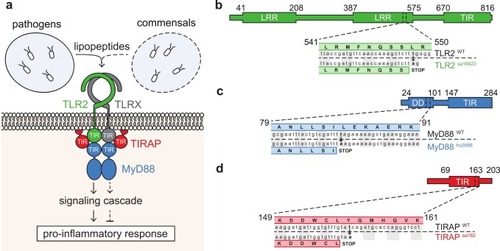Fig. 1
- ID
- ZDB-FIG-220718-79
- Publication
- Brinkmann et al., 2022 - Microbiota-dependent TLR2 signaling reduces silver nanoparticle toxicity to zebrafish larvae
- Other Figures
- All Figure Page
- Back to All Figure Page
|
Fig. 1. Mutant zebrafish lines in the TLR2 signaling pathway. (a) Schematic representation of TLR2 with its adaptor proteins MyD88 and TIRAP (Mal). The Toll/IL-1 receptor (TIR) domain of MyD88 and TIRAP (Mal) can interact with the TIR domain of TLR2. Pathogens have been found to induce pro-inflammatory immune responses via TLR2 (solid line), while commensal microbiota have been shown to dampen pro-inflammatory responses via TLR2 (dashed line). (b-d) Mutant and wildtype alleles with encoded proteins for TLR2 (tlr2sa19423 mutant allele) (b); MyD88 (myd88hu3568 mutant allele) (c); and TIRAP (Mal) (tirapsa182 mutant allele) (d). In all mutant alleles, a threonine to alanine point mutation results in a premature stop codon prior to or inside of the open reading frame for the TIR domain. As a consequence, the mutants produce truncated versions of TLR2, MyD88 or TIRAP, lacking a functional TIR domain. Abbreviations: DD, death domain; LRR, leucine rich repeat; Mal, MyD88 Adaptor-Like; MyD88, Myeloid Differentiation factor 88; TIR, Toll/IL-1 receptor domain; TIRAP, Toll/Interleukin-1 Receptor domain-containing Adaptor Protein; TLR, Toll-Like Receptor. |

